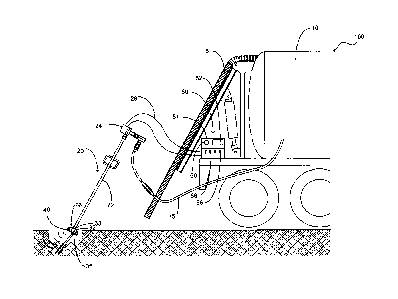Une partie des informations de ce site Web a été fournie par des sources externes. Le gouvernement du Canada n'assume aucune responsabilité concernant la précision, l'actualité ou la fiabilité des informations fournies par les sources externes. Les utilisateurs qui désirent employer cette information devraient consulter directement la source des informations. Le contenu fourni par les sources externes n'est pas assujetti aux exigences sur les langues officielles, la protection des renseignements personnels et l'accessibilité.
L'apparition de différences dans le texte et l'image des Revendications et de l'Abrégé dépend du moment auquel le document est publié. Les textes des Revendications et de l'Abrégé sont affichés :
| (12) Demande de brevet: | (11) CA 3043826 |
|---|---|
| (54) Titre français: | SYSTEME D`EXCAVATION HYDRAULIQUE AVEC DETECTION D`OBJETS |
| (54) Titre anglais: | HYDROVAC EXCAVATION SYSTEM HAVING OBJECT DETECTION |
| Statut: | Examen |
| (51) Classification internationale des brevets (CIB): |
|
|---|---|
| (72) Inventeurs : |
|
| (73) Titulaires : |
|
| (71) Demandeurs : |
|
| (74) Agent: | RICHARD D. OKIMAWOKIMAW, RICHARD D. |
| (74) Co-agent: | |
| (45) Délivré: | |
| (22) Date de dépôt: | 2019-05-21 |
| (41) Mise à la disponibilité du public: | 2020-11-17 |
| Requête d'examen: | 2024-04-22 |
| Licence disponible: | S.O. |
| Cédé au domaine public: | S.O. |
| (25) Langue des documents déposés: | Anglais |
| Traité de coopération en matière de brevets (PCT): | Non |
|---|
| (30) Données de priorité de la demande: | ||||||
|---|---|---|---|---|---|---|
|
An excavation system that is configured to utilize water pressure and
vacuum to provide removal of terrain from an area wherein the excavation
system
is further configured to provide detection and alert of subterranean objects
in the
excavation area. The excavation system includes a digging wand that is
operably
coupled to a water source. The digging wand includes a plurality of water jets
that
are configured to emit water. The digging wand further includes in the nozzle
thereof a plurality of detection transceivers. The detection transceivers are
configured to provide detection of subterranean objects proximate the nozzle
of the
digging wand during the excavation process. The controller of the present
invention
includes a screen that provides image data of the area proximate the nozzle.
The
controller further provides at least two operational modes wherein one of the
operational modes provides reduction of water pressure upon detection of a
subterranean object.
Note : Les revendications sont présentées dans la langue officielle dans laquelle elles ont été soumises.
Note : Les descriptions sont présentées dans la langue officielle dans laquelle elles ont été soumises.

2024-08-01 : Dans le cadre de la transition vers les Brevets de nouvelle génération (BNG), la base de données sur les brevets canadiens (BDBC) contient désormais un Historique d'événement plus détaillé, qui reproduit le Journal des événements de notre nouvelle solution interne.
Veuillez noter que les événements débutant par « Inactive : » se réfèrent à des événements qui ne sont plus utilisés dans notre nouvelle solution interne.
Pour une meilleure compréhension de l'état de la demande ou brevet qui figure sur cette page, la rubrique Mise en garde , et les descriptions de Brevet , Historique d'événement , Taxes périodiques et Historique des paiements devraient être consultées.
| Description | Date |
|---|---|
| Lettre envoyée | 2024-06-19 |
| Exigences pour une requête d'examen - jugée conforme | 2024-04-22 |
| Toutes les exigences pour l'examen - jugée conforme | 2024-04-22 |
| Requête d'examen reçue | 2024-04-22 |
| Inactive : Lettre officielle | 2024-03-28 |
| Inactive : Lettre officielle | 2024-03-28 |
| Demande publiée (accessible au public) | 2020-11-17 |
| Inactive : Page couverture publiée | 2020-11-16 |
| Représentant commun nommé | 2019-10-30 |
| Représentant commun nommé | 2019-10-30 |
| Inactive : CIB en 1re position | 2019-06-12 |
| Inactive : CIB attribuée | 2019-06-12 |
| Inactive : Certificat dépôt - Aucune RE (bilingue) | 2019-06-07 |
| Exigences de dépôt - jugé conforme | 2019-06-07 |
| Inactive : Demandeur supprimé | 2019-06-04 |
| Inactive : CIB attribuée | 2019-05-28 |
| Inactive : CIB attribuée | 2019-05-28 |
| Inactive : CIB attribuée | 2019-05-28 |
| Demande reçue - nationale ordinaire | 2019-05-24 |
| Déclaration du statut de petite entité jugée conforme | 2019-05-21 |
Il n'y a pas d'historique d'abandonnement
Le dernier paiement a été reçu le
Avis : Si le paiement en totalité n'a pas été reçu au plus tard à la date indiquée, une taxe supplémentaire peut être imposée, soit une des taxes suivantes :
Veuillez vous référer à la page web des taxes sur les brevets de l'OPIC pour voir tous les montants actuels des taxes.
| Type de taxes | Anniversaire | Échéance | Date payée |
|---|---|---|---|
| Taxe pour le dépôt - petite | 2019-05-21 | ||
| TM (demande, 2e anniv.) - petite | 02 | 2021-05-21 | 2021-04-09 |
| TM (demande, 3e anniv.) - petite | 03 | 2022-05-24 | 2022-04-20 |
| TM (demande, 4e anniv.) - petite | 04 | 2023-05-23 | 2023-05-18 |
| TM (demande, 5e anniv.) - petite | 05 | 2024-05-21 | 2024-04-22 |
| Requête d'examen - petite | 2024-05-21 | 2024-04-22 | |
| TM (demande, 6e anniv.) - petite | 06 | 2025-05-21 |
Les titulaires actuels et antérieures au dossier sont affichés en ordre alphabétique.
| Titulaires actuels au dossier |
|---|
| WILLIAM AUCLAIR |
| Titulaires antérieures au dossier |
|---|
| S.O. |